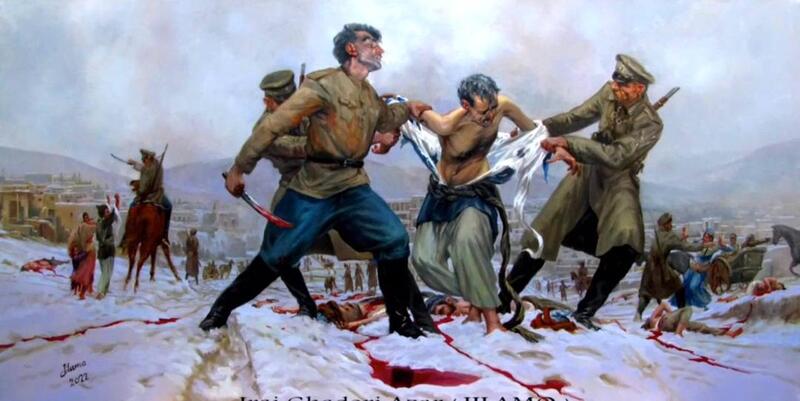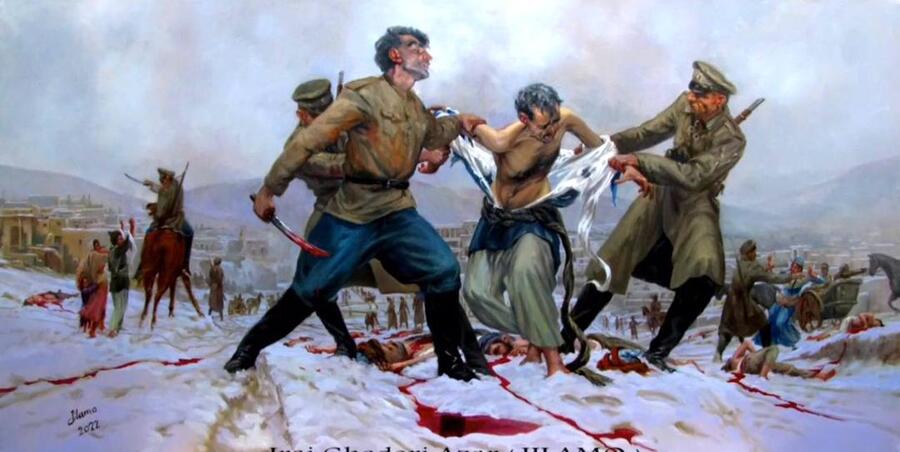Read the following two articles to read the history related to this article:
The Genocide of Mahabad People by Two Superpowers; the Ottomans and the Russians - Part 1
The Genocide of Mahabad People by Two Superpowers; the Ottomans and the Russians - Part 2
With the remarks mentioned before, if we talk about the painting "Bloody Rivers in the Snow", the characteristics are: The painting's lines are columnar. There are about 19 people, eight of whom are corpses lying on the ground and dead. There are two women on the right and left of the painting, one in a red dree and the other in a blue. In the middle of the painting, we see three Russian men holding a Kurdish man, pulling his clothes, and attacking him with a sword. Obviously, since his clothes are Kurdish and he is wearing a kawa, pshten, patol, and Sorani, the man appears Kurdish. On the right side of the painting is a man attacking a Kurdish woman, the man is Russian and the woman is Kurdish based on her dress. The woman holds up her hands in surrender. The place is on the heights of Mahabad. The city is shown in a gloomy atmosphere. Blood is frozen in the snow, and there are massacres, corpses, the Kurdish people's frightened faces, and the Russian soldiers' frightening faces. Obviously, the painting was created to show the cruelty of the Russians, the suffering of the Kurdish people of Mahabad, and their loneliness. No Kurd in the photo is armed. We see unarmed people in front of Russian guns, cannons, and daggers. Even if you look closely, there is a cannon on the right side of the painting. The Kurds are still very empty-handed and alone in the face of Russian guns, cannons, and daggers. The Russian warrior's campaign against the woman in the sky on the right of the painting shows the oppression and violence committed by the Russians against Kurdish women in Mahabad, a fact that has been mentioned in most reports and is undeniable.

The presence of eight bloody dead bodies occupying the entire width of the painting is another space. This is the order of the massacre of tens of thousands of people in Mahabad. The fall of the bodies in the horizontal position of the painting indicates the massive killing of the people of Mahabad. The hazy horizon of a city between the mountains and behind the Russians indicates the future of the city so that it is as if the city cannot be seen until the Russians leave. The painting shows three parts of the conflict between the Kurdish people and Russian soldiers. The first part is the right-hand theater, where we said the woman in the blue is completely embarrassed and has both hands raised. The middle stage is the Kurdish man, who is about to be killed by Russian soldiers, and on the left side is a Kurdish man and woman in red raising their hands in front of the Russian soldiers. All three scenes and the bodies on the snow represent the powerlessness and loneliness of the Kurdish people in the direction of the time and place of world history, which is the war of World War I.
All this shows that the Kurdish people have no state, supporters, or even a national leader to support them. Another creature in the painting is the horse, which symbolizes sovereignty. The horse has often been a symbol of sovereignty in paintings. There are four horses, two of which have Russian riders, and two of which are standing there. The living people in the painting, seen in perspective and from a distance, are mostly Russian according to the color of their clothes and the dead on the ground are all Kurds, which is a sign of the power and domination of the Russian army. According to the points mentioned; the painting "Bloody Rivers in the Snow" created in 2022 by artist Iraj Qaderi Azar is in the style of realism that expresses the real without mixing imagination, shows beauty with beauty, and hatred with hatred. The painting shows the suffering, sorrow, oppression, and loneliness of the Kurdish people in World War I when no force came to their aid of the Kurds. Even the Iranian government did not do anything to help or support them.
Note: "The text of Ms. Leila Salihi's speech at the Bukan Ladies of Word and Book Conference, about the painting "Bloody Rivers in the Snow", written on paper and transcribed by Kurdshop.









